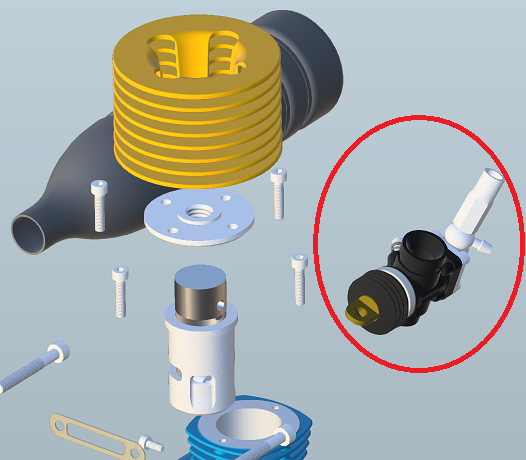20 Dec 2016
Selective explode in the viewer

Here is a question that was asked by a developer during our last accelerator: How to exclude some components from being exploded in a model?
Well, there is no API method directly exposed to achieve that, so I dig in the viewer source code and extracted the piece of code that handles the explosion transforms, then customized it a bit by adding an if condition that will prevent the passed fragment ids from being transformed.
Here is the method, I named that selectiveExplode:
| function selectiveExplode (viewer, scale, excludedFragIds, model) { | |
| model = model || viewer.model | |
| var svf = model.getData(); | |
| var mc = model.getVisibleBounds(true).center(); | |
| var fragList = model.getFragmentList(); | |
| var pt = new THREE.Vector3(); | |
| //Input scale is in the range 0-1, where 0 | |
| //means no displacement, and 1 maximum reasonable displacement. | |
| scale *= 2; | |
| //If we have a full part hierarchy we can use a | |
| //better grouping strategy when exploding | |
| if (svf.instanceTree && svf.instanceTree.nodeAccess.nodeBoxes && scale !== 0) { | |
| var scaledExplodeDepth = scale * (svf.instanceTree.maxDepth - 1) + 1; | |
| var explodeDepth = 0 | scaledExplodeDepth; | |
| var currentSegmentFraction = scaledExplodeDepth - explodeDepth; | |
| var it = svf.instanceTree; | |
| var tmpBox = new Float32Array(6); | |
| (function explodeRec(nodeId, depth, cx, cy, cz, ox, oy, oz) { | |
| var oscale = scale * 2; | |
| // smooth transition of this tree depth | |
| // from non-exploded to exploded state | |
| if (depth == explodeDepth) | |
| oscale *= currentSegmentFraction; | |
| it.getNodeBox(nodeId, tmpBox); | |
| var mycx = 0.5 * (tmpBox[0] + tmpBox[3]); | |
| var mycy = 0.5 * (tmpBox[1] + tmpBox[4]); | |
| var mycz = 0.5 * (tmpBox[2] + tmpBox[5]); | |
| if (depth > 0 && depth <= explodeDepth) { | |
| var dx = (mycx - cx) * oscale; | |
| var dy = (mycy - cy) * oscale; | |
| var dz = (mycz - cz) * oscale; | |
| //var omax = Math.max(dx, Math.max(dy, dz)); | |
| ox += dx; | |
| oy += dy; | |
| oz += dz; | |
| } | |
| svf.instanceTree.enumNodeChildren(nodeId, function(dbId) { | |
| explodeRec(dbId, depth+1, mycx, mycy, mycz, ox, oy, oz); | |
| }, false); | |
| svf.instanceTree.enumNodeFragments(nodeId, function(fragId) { | |
| if(excludedFragIds.indexOf(fragId.toString()) < 0) { | |
| pt.x = ox; | |
| pt.y = oy; | |
| pt.z = oz; | |
| fragList.updateAnimTransform(fragId, null, null, pt); | |
| } | |
| }, false); | |
| })(svf.instanceTree.getRootId(), 0, mc.x, mc.y, mc.x, 0, 0, 0); | |
| } else { | |
| var boxes = fragList.fragments.boxes; | |
| var nbFrags = fragList.getCount() | |
| for (var fragId = 0; fragId < nbFrags; ++fragId) { | |
| if(excludedFragIds.indexOf(fragId) < 0) { | |
| if (scale == 0) { | |
| fragList.updateAnimTransform(fragId); | |
| } else { | |
| var box_offset = fragId * 6; | |
| var cx = 0.5 * (boxes[box_offset] + boxes[box_offset + 3]); | |
| var cy = 0.5 * (boxes[box_offset + 1] + boxes[box_offset + 4]); | |
| var cz = 0.5 * (boxes[box_offset + 2] + boxes[box_offset + 5]); | |
| cx = scale * (cx - mc.x); | |
| cy = scale * (cy - mc.y); | |
| cz = scale * (cz - mc.z); | |
| pt.x = cx; | |
| pt.y = cy; | |
| pt.z = cz; | |
| fragList.updateAnimTransform(fragId, null, null, pt); | |
| } | |
| } | |
| } | |
| } | |
| } |
You can cut and paste that code here to quickly test it, simply replace the load method by this one with predefined fragment Ids:
| _this.load = function () { | |
| var excludedFragIds = [ | |
| 6, 14, 18, 22, 24, 33, 35, 49, 53, | |
| 63, 65, 67, 68, 69, 74, 79, 80, 81, 82 | |
| ] | |
| selectiveExplode ( | |
| viewer, 0.5, excludedFragIds, viewer.model) | |
| viewer.impl.sceneUpdated(true) | |
| return true | |
| } |
This will prevent the carburator ("Carb:1") from being exploded:





